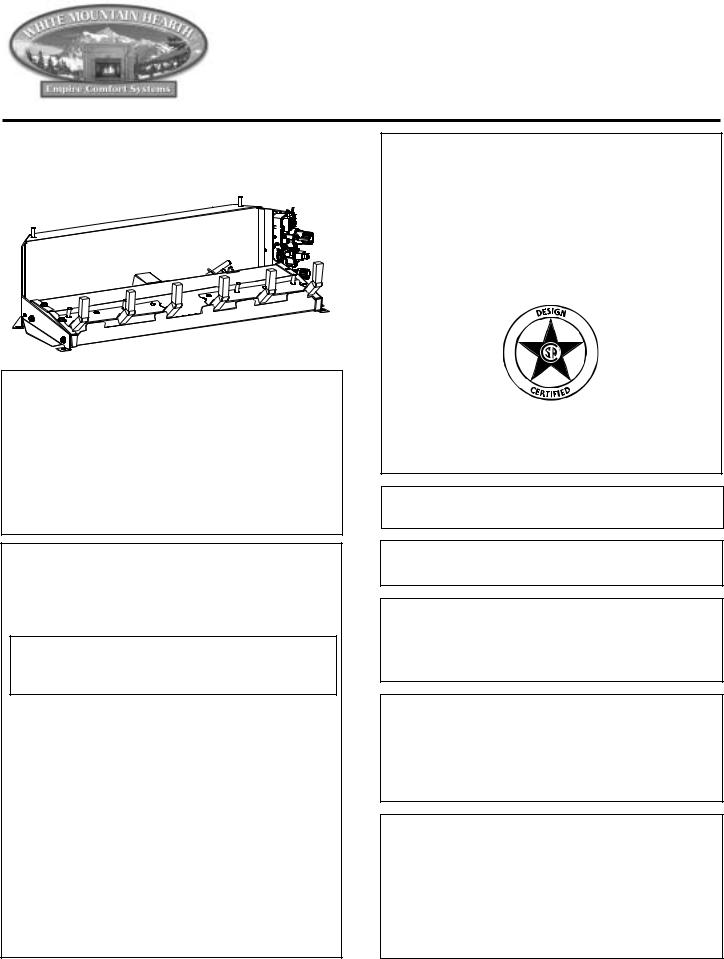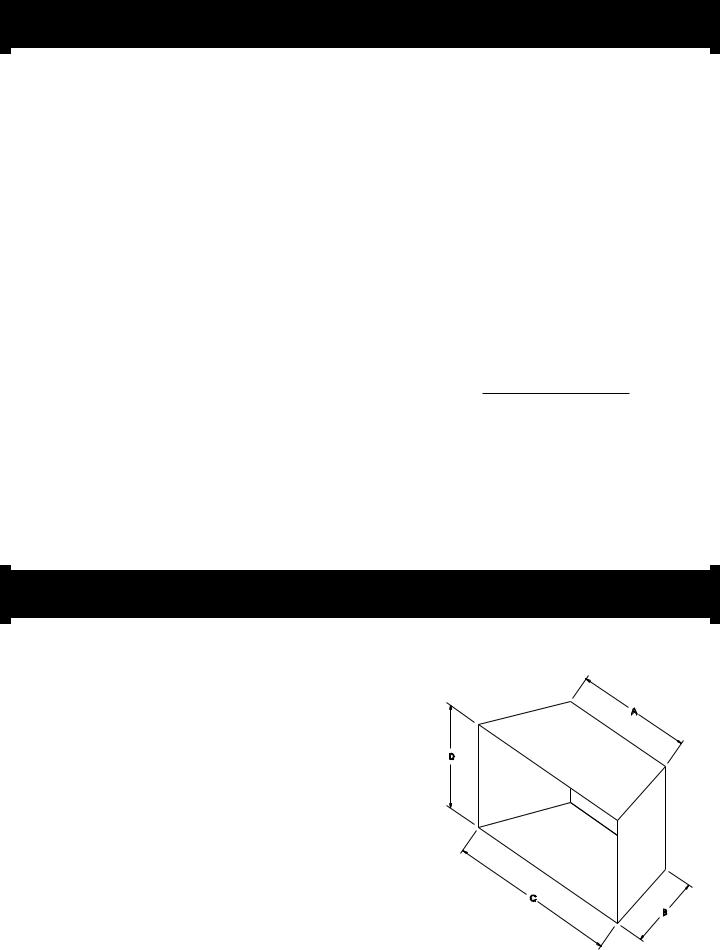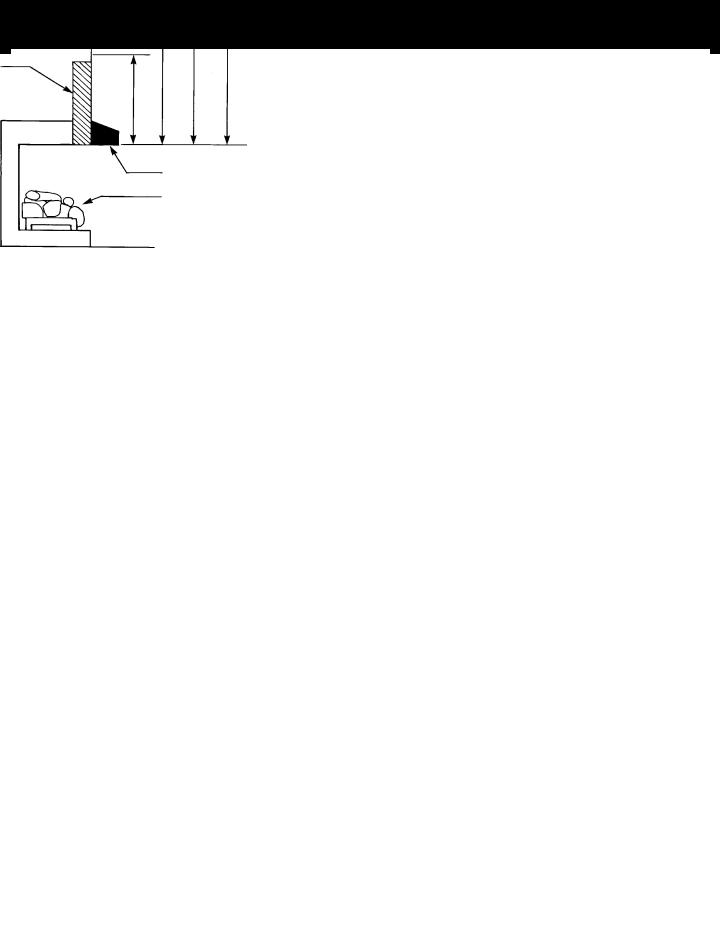Empire Comfort Systems VFSR-18-3 User Manual

INSTALLATION INSTRUCTIONS
AND OWNER'S MANUAL
The White Mountain
Vent-Free Burner
This appliance may be installed in an aftermarket permanently located, manufactured (mobile) home, where not prohibited by local codes.
This appliance is only for use with the type of gas indicated on the rating plate. This appliance is not convertible for use with other gases.
WARNINGS
If the information in this manual is not followed exactly, a fire or explosion may result causing property damage, personal injury or loss of life.
–Do not store or use gasoline or other flammable vapors and liquids in the vicinity of this or any other appliance.
WHAT TO DO IF YOU SMELL GAS
•Do not try to light any appliance.
•Do not touch any electrical switch; do not use any phone in your building.
•Immediately call your gas supplier from neighbor’s phone. Follow the gas supplier’s instructions.
•If you cannot reach your gas supplier, call the fire department.
–Installation and service must be performed by a qualified installer, service agency or the gas supplier.
UNVENTED GAS LOG HEATER OR VENTED DECORATIVE APPLIANCE
MODELS
VFSR-16-3 |
VFSV-16-3 |
|
VFSV-18-3 |
||
VFSR-18-3 |
||
VFSV-24-3 |
||
VFSR-24-3 |
||
VFSV-30-3 |
||
VFSR-30-3 |
||
|
EFFECTIVE DATE
APRIL, 2003
Installer: Please leave these instructions with the consumer.
Consumer: Please retain these instructions for future use.
This is an unvented gas-fired heater. It uses air (oxygen) from the room in which it is installed. Provisions for adequate combustion and ventilation air must be provided. Refer to page 7.
WARNING: If not installed, operated and maintained in accordance with the manufacturer's instructions, this product could expose you to substances in fuel or from fuel combustion which can cause death or serious illness.
WATER VAPOR: A BY-PRODUCT OF UNVENTED ROOM HEATERS
Water vapor is a by-product of gas combustion. An unvented room heater produces approximately one (1) ounce (30ml) of water for every 1,000 BTU's (.3KW's) of gas input per hour. Refer to page 6.
14008-0-0403 |
Page 1 |

TABLE OF CONTENTS |
|
Section |
Page |
Important Safety Information ......................................................................................................................... |
3 |
Safety Information for Users of LP Gas ......................................................................................................... |
4 |
Introduction .................................................................................................................................................... |
5 |
General Information ....................................................................................................................................... |
6 |
Water Vapor: By Product of Unvented Room Heaters ................................................................................... |
6 |
Provisions for Adequate Combustion and Ventilation Air ............................................................................. |
7 |
Clearances ................................................................................................................................................... |
7-8 |
Combustible Material ..................................................................................................................................... |
9 |
Fireplace Preparation ...................................................................................................................................... |
9 |
Installing as a Vented Appliance .................................................................................................................. |
10 |
Before Fully Installing the Appliance .......................................................................................................... |
10 |
Gas Supply ................................................................................................................................................... |
11 |
Log Grate Placement .................................................................................................................................... |
12 |
Placement of Glowing Embers and Lava Rock ........................................................................................... |
12 |
Operation Instructions/Flame Appearance ................................................................................................... |
13 |
VFSR-(16, 18, 24, 30) Lighting Instructions ............................................................................................... |
14 |
VFSV-(16, 18, 24, 30) Lighting Instructions ............................................................................................... |
15 |
Pilot Flame Characteristics ...................................................................................................................... |
16-17 |
Cleaning and Servicing ................................................................................................................................ |
17 |
Wiring ........................................................................................................................................................... |
18 |
Troubleshooting ............................................................................................................................................ |
19 |
Parts List ....................................................................................................................................................... |
20 |
Parts View ..................................................................................................................................................... |
21 |
How to Order Repair Parts ........................................................................................................................... |
21 |
Service Notes ........................................................................................................................................... |
22-23 |
Page 2 |
14008-0-0403 |

IMPORTANT SAFETY INFORMATION
•An unvented room heater having an input rating of more than 6,000 Btu per hour shall not be installed in a bathroom
•An unvented room heater having an input rating of more than 10,000 Btu per hour shall not be installed in a bedroom or bathroom.
•Never burn solid fuels in a fireplace where a gas log set is installed.
•Due to high temperatures, the appliance should be located out of traffic and away from furniture and draperies.
•Do not place clothing or other flammable material on or near the appliance.
•Children and adults should be alerted to the hazards of high surface temperature and should stay away to avoid burns or clothing ignition.
•Young children should be carefully supervised when they are in the same room as the appliance.
•This unit complies with ANSI Z21.11.2b-2002 Unvented Heaters and it also complies with ANSI Z21.60b-2001 Decorative Vented Appliances for Solid Fuel Burning Fireplaces. State or local codes may only allow operation of this appliance in a vented configuration. Check your state or local codes.
•Correct installation of logs, proper location of the heater and annual cleaning are necessary to avoid potential problems with sooting. Sooting, resulting from improper installation or operation, can settle on surfaces outside the fireplace.
•Avoid any drafts that could alter burner flame patterns. Do not allow fans to blow directly into the fireplace. Do not place a blower inside burn box area of firebox. Ceiling fans may create drafts that alter burner flame patterns. Sooting and improper burning will occur as a result of drafts.
•Periodic examination and cleaning of the venting system of the solid-fuel burning fireplace, including frequency of such examination and cleaning, by a qualified agency.
•The installation must conform with local codes or, in the absence of local codes, with the National Fuel Gas Code, ANSI Z223.1 (latest edition) and to the National Electrical Code, ANSI/NFPA70 (latest edition).
•NOTE: Installation and repair should be done by a qualified service person. The appliance should be inspected before use and at least annually by a qualified service person. More frequent cleaning may be required due to excessive lint from carpeting, bedding material, etc. It is imperative that the control compartment, burners and circulating air passageways of the appliance be kept clean.
•Any safety screen or guard removed for servicing an appliance must be replaced prior to operating the appliance. Provide adequate combustion and ventilation air.
•The flow of combustion and ventilation air MUST NOT be obstructed.
•Provide adequate clearances around air openings into the combustion chamber and adequate accessibility clearance for servicing and proper operation. NEVER obstruct the front opening of the appliance.
•An unvented room heater intended for installation in a solid-fuel burning fireplace shall comply with the following instructions.
•A fireplace screen must be in place when the appliance is operating and, unless other provisions for combustion air are provided, the screen shall have an opening(s) for introduction of combustion air.
•Solid-fuels shall not be burned in a masonry or UL 127 factory-built fireplace in which an unvented room heater is installed.
•Any glass doors shall be fully opened when the appliance is in operation.
•Any outside air ducts and/or ash dumps in the fireplace shall be permanently closed at time of appliance installation.
•WARNING: Failure to keep the primary air opening(s) of the burner(s) clean may result in sooting and property damage.
WARNING
When used without adequate combustion and ventilation air, heater may give off CARBON MONOXIDE, an odorless, poisonous gas.
Do not install heater until all necessary provisions are made for combustion and ventilation air. Consult the written instructions provided with the heater for information concerning combustion and ventilation air. In the absence of instructions, refer to the National Fuel Gas Code, ANSI Z223.1, Section 5.3 or applicable local codes.
This heater is equipped with a PILOT LIGHT SAFETY SYSTEM designed to turn off the heater if not enough fresh air is available.
DO NOT TAMPER WITH PILOT LIGHT SAFETY SYSTEM!
If heater shuts off, do not relight until you provide fresh air.
If heater keeps shutting off, have it serviced. Keep burner and control compartment clean.
CARBON MONOXIDE POISONING MAY LEAD TO DEATH.
Early signs of carbon monoxide poisoning resemble the flu, with headache, dizziness and/or nausea. If you have these signs, heater may not be working properly. Get fresh air at once! Have heater serviced.
Some people – pregnant women, persons with heart or lung disease, anemia, those under the influence of alcohol, those at high altitudes – are more affected by carbon monoxide than others.
The pilot light safety system senses the depletion of oxygen at its location. If this heater is installed in a structure having a high vertical dimension, the possibility exists that the oxygen supply at the higher levels will be less than that at the heater. In this type of application, a fan to circulate the structure air will minimize this effect. The use of this fan will also improve the comfort level in the structure. When a fan is used to circulate air, it should be located so that the air flow is not directed at the burner.
14008-0-0403 |
Page 3 |

SAFETY INFORMATION FOR USERS OF LP-GAS
Propane (LP-Gas) is a flammable gas which can cause fires and explosions. In its natural state, propane is odorless and colorless. You may not know all the following safety precautions which can protect both you and your family from an accident. Read them carefully now, then review them point
by point with the members of your household. Someday when there may not be a minute to lose, everyone's safety will depend on knowing exactly what to do. If, after reading the following information, you feel you still need more information, please contact your gas supplier.
LP-GAS WARNING ODOR
If a gas leak happens, you should be able to smell the gas because of the odorant put in the LP-Gas. That's your signal to go into immediate action!
•Do not operate electric switches, light matches, use your phone. Do not do anything that could ignite the gas.
•Get everyone out of the building, vehicle, trailer, or area. Do that IMMEDIATELY.
•Close all gas tank or cylinder supply valves.
•LP-Gas is heavier than air and may settle in low areas such as basements. When you have reason to suspect a gas leak, keep out of basements and other low areas. Stay out until firefighters declare them to be safe.
•Use your neighbor's phone and call a trained LP-Gas service person and the fire department. Even though you may not continue to smell gas, do not turn on the gas again. Do not reenter the building, vehicle, trailer, or area.
•Finally, let the service man and firefighters check for escaped gas. Have them air out the area before you return. Properly trained LP-Gas service people should repair the leak, then check and relight the gas appliance for you.
NO ODOR DETECTED - ODOR FADE
Some people cannot smell well. Some people cannot smell the odor of the chemical put into the gas. You must find out if you can smell the odorant in propane. Smoking can decrease your ability to smell. Being around an odor for a time can affect your sensitivity or ability to detect that odor. Sometimes other odors in the area mask the gas odor. People may not smell the gas odor or their minds are on something else. Thinking about smelling a gas odor can make it easier to smell.
The odorant in LP-gas is colorless, and it can fade under some circumstances. For example, if there is an underground leak, the movement of the gas through soil can filter the odorant. Odorants in LP-Gas also are subject to oxidation. This fading can
occur if there is rust inside the storage tank or in iron gas pipes.
The odorant in escaped gas can adsorb or absorb onto or into walls, masonry and other materials and fabrics in a room. That will take some of the odorant out of the gas, reducing its odor intensity.
LP-Gas may stratify in a closed area, and the odor intensity could vary at different levels. Since it is heavier than air, there may be more odor at lower levels. Always be sensitive to the slightest gas odor. If you detect any odor, treat it as a serious leak. Immediately go into action as instructed earlier.
SOME POINTS TO REMEMBER
•Learn to recognize the odor of LP-gas. Your local LP-Gas Dealer can give you a "Scratch and Sniff" pamphlet. Use it to find out what the propane odor smells like. If you suspect that your LP-Gas has a weak or abnormal odor, call your LP-Gas Dealer.
•If you are not qualified, do not light pilot lights, perform service, or make adjustments to appliances on the LP-Gas system. If you are qualified, consciously think about the odor of LP-Gas prior to and while lighting pilot lights or performing service or making adjustments.
•Sometimes a basement or a closed-up house has a musty smell that can cover up the LP-Gas odor. Do not try to light pilot lights, perform service, or make adjustments in an area where the conditions are such that you may not detect the odor if there has been a leak of LP-Gas.
•Odor fade, due to oxidation by rust or adsorption on walls of new cylinders and tanks, is possible. Therefore, people should be particularly alert and careful when new tanks or cylinders are placed in service. Odor fade can occur in new tanks, or reinstalled old tanks, if they are filled and allowed
to set too long before refilling. Cylinders and tanks which have been out of service for a time may develop internal rust which will cause odor fade. If such conditions are suspected to exist, a periodic sniff test of the gas is advisable. If you have any question about the gas odor, call your LP-gas dealer. A periodic sniff test of the LP-gas is a good safety measure under any condition.
•If, at any time, you do not smell the LP-Gas odorant and you think you should, assume you have a leak. Then take the same immediate action recommended above for the occasion when you do detect the odorized LP-Gas.
•If you experience a complete "gas out," (the container is under no vapor pressure), turn the tank valve off immediately. If the container valve is left on, the container may draw in some air through openings such as pilot light orifices. If this occurs, some new internal rusting could occur. If the valve is left open, then treat the container as a new tank. Always be sure your container is under vapor pressure by turning it off at the container before it goes completely empty or having it refilled before it is completely empty.
Page 4 |
14008-0-0403 |

INTRODUCTION
IMPORTANT: Read all instructions carefully before starting installation. Failure to follow these installation instructions may result in a possible fire hazard and will void the warranty.
Save this manual for future reference.
Please read this manual before installing and using the appliance. Instructions to Installer
1.Installer must leave instruction manual with owner after installation.
2.Installer must have owner fill out and mail warranty card supplied with unvented room heater/vented decorative appliance.
3.Installer should show owner how to start and operate unvented room heater/vented decorative appliance.
Always consult your local Building Department regarding regulations, codes or ordinances which apply to the installation of an unvented room heater/vented decorative appliance.
This appliance may be installed in an aftermarket* manufactured (mobile) home, where not prohibited by state or local codes.
*Aftermarket: Completion of sale, not for purpose of resale, from the manufacturer.
This appliance is only for use with the type of gas indicated on the rating plate. This appliance is not convertible for use with other gases.
New Installation
VFSV Model - variable does not operate-ON is OFF/OFF is ON-wires into the back of receiver are reversed.
Solid-fuels shall not be burned in a fireplace where a vented decorative appliance is installed.
A vented decorative appliance must be installed only in a solid-fuel burning fireplace with a working flue and constructed of non-combustible material.
Any alteration of the original design, installed other than as shown in these instructions or use with a type of gas not shown on the rating plate is the responsibility of the person and company making the change.
Important
All correspondence should refer to complete Model Number, Serial Number and type of gas.
Attention: During initial use of log you will detect an odor as the log is cured.
Notice: During initial firing of this unit, its paint will bake out, and smoke will occur. To prevent triggering of smoke alarms, ventilate the room in which the unit is installed.
WARNING: This appliance is for installation only in a solidfuel burning masonry or UL 127 factory-built fireplace or in a listed ventless firebox enclosure. It has been design certified for these installations. Exception: DO NOT install this appliance in a factory-built fireplace that includes instructions stating it has not been tested or should not be used with unvented gas logs.
WARNING: Any modification to this unvented gas heater or its controls can be dangerous. Improper installation or use of the heater can cause serious injury or death from fire, burns, explosion or carbon monoxide poisoning.
Well Head Gas Installations
Some natural gas utilities use "well head" gas. This may affect the Btu output of the unit. Contact the gas company for the heating value. Contact the manufacturer or your gas company before changing spud/ orifice size.
ACCESSORIES
|
Description |
Color |
|
|
|
For use with VFSV and VFSR models |
|
|
|
|
|
EK-1 |
Embers Kit |
|
ELH-1 |
Fireplace Hood for Vent-Free Logs |
Black |
ELH-2 |
Fireplace Hood for Vent-Free Logs |
Brass |
For use with VFSR models only |
|
|
|
|
|
FRBC |
Battery Operated Remote Control |
|
FRBTC |
Battery Operated Remote Control with Thermostat |
|
FREC |
Electric Remote Control |
|
FWS |
Wall Switch |
|
GWSG-T |
Wall Thermostat, Millivolt |
|
TMV |
Wall Thermostat, Millivolt - Reed Switch |
|
PRODUCT SPECIFICATION
|
|
|
|
Natural Gas |
|
|
Propane Gas |
|
||
|
|
|
Variable |
|
Millivolt |
|
Variable |
Millivolt |
|
|
|
Regulator pressure setting |
3.5" W.C. |
|
3.5" W.C. |
|
10.0" W.C. |
10.0" W.C |
|
|
|
|
Gas inlet pressure |
Max. |
10.5" W.C. |
10.5" W.C. |
|
13.0"W.C. |
13.0" W.C. |
|
|
|
|
|
Min. |
5.0" W.C. |
|
5.0" W.C. |
|
11.0" W.C. |
11.0" W.C. |
|
|
|
|
|
|
|
|
|
|
|
|
|
|
|
|
|
|
|
BTUH |
|
BTUH |
||
|
Model |
Gas |
Valve Type |
Max. Rate |
Min. Rate |
|||||
|
|
|
|
|
|
|
|
|
|
|
|
VFSV-16 |
Natural |
|
Variable |
|
25,000 |
|
17,500 |
|
|
|
VFSV-16 |
Propane |
|
Variable |
|
22,500 |
|
15,750 |
|
|
|
VFSR-16 |
Natural |
|
Millivolt |
|
25,000 |
|
17,500 |
|
|
|
VFSR-16 |
Propane |
|
Millivolt |
|
22,500 |
|
15,750 |
|
|
|
VFSV-18 |
Natural |
|
Variable |
|
32,000 |
|
19,000 |
|
|
|
VFSV-18 |
Propane |
|
Variable |
|
32,000 |
|
19,000 |
|
|
|
VFSR-18 |
Natural |
|
Millivolt |
|
32,000 |
|
22,000 |
|
|
|
VFSR-18 |
Propane |
|
Millivolt |
|
32,000 |
|
22,000 |
|
|
|
VFSV-24 |
Natural |
|
Variable |
|
36,000 |
|
20,000 |
|
|
|
VFSV-24 |
Propane |
|
Variable |
|
36,000 |
|
20,000 |
|
|
|
VFSR-24 |
Natural |
|
Millivolt |
|
36,000 |
|
25,000 |
|
|
|
VFSR-24 |
Propane |
|
Millivolt |
|
36,000 |
|
25,000 |
|
|
|
VFSV-30 |
Natural |
|
Variable |
|
38,000 |
|
20,000 |
|
|
|
VFSV-30 |
Propane |
|
Variable |
|
38,000 |
|
20,000 |
|
|
|
VFSR-30 |
Natural |
|
Millivolt |
|
38,000 |
|
26,000 |
|
|
|
VFSR-30 |
Propane |
|
Millivolt |
|
38,000 |
|
26,000 |
|
|
14008-0-0403 |
Page 5 |

GENERAL INFORMATION
This is an unvented gas-fired heater. It uses air (oxygen) from the room in which it is installed. Provisions for adequate combustion and ventilation air must be provided.
Keep room area clear and free from combustible materials, gasoline and other flammable vapors and liquids.
Unvented gas heaters are a supplemental zone heater. They are not intended to be a primary heating appliance. Water vapor produced by an unvented heater can create moisture problems in a home when operated for extended periods of time.
During manufacturing, fabricating and shipping, various components of this appliance are treated with certain oils, films or bonding agents. These chemicals are not harmful but may produce annoying smoke and smells as they are burned off during the initial operation of the appliance; possibly causing headaches or eye or lung irritation. This is a normal and temporary occurrence.
The initial break-in operation should last 2-3 hours with the burner at the highest setting. Provide maximum ventilation by opening windows or doors to allow odors to dissipate. Any odors remaining after this initial break-in period will be slight and will disappear with continued use.
This appliance must not be used with glass doors in the closed position. This can lead to pilot outages and severe sooting outside the fireplace.
Do not use this room heater if any part has been under water. Immediately call a qualified service technician to inspect the room heater and replace any part of the control system and any gas control which has been under water.
Before you get started
Carefully inspect the contents for shipping damage. If any parts are missing or damaged, immediately inform the dealer from whom you purchased the appliance. Do not attempt to install any part of the appliance unless you have all parts in good condition.
Make sure you have received all parts:
Check your packing list to verify that all listed parts have been received. You should have the following:
•Gas log grate/burner assembly.
•Two (2) masonry anchoring screws and two (2) 10 x 1/2" black sheet metal anchoring screws.
•Plastic bag containing glowing embers (rock wool) for burner coverage.
•Plastic bag containing lava rock.
•Switch log assembly - VFSR models
•Remote kit - VFSV models
Millivolt controlled heater designed to be operated with optional devices for ON/OFF functions.
•Wall switch or thermostat with wire.
•Hand held remote control with ON/OFF switch or thermostat.
Handle the gas log burner assembly by the grate and legs only. Do not pick the unit up by the burner.
Gloves are recommended when handling logs to prevent skin irritation. Logs are fragile - Handle with care.
Qualified Installing Agency
Installation and replacement of gas piping, gas utilization equipment or accessories and repair and servicing of equipment shall be performed only by a qualified agency. The term "qualified agency" means any individual, firm, corporation, or company that either in person or through a representative is engaged in and is responsible for (a) the installation, testing, or replacement of gas piping or (b) the connection, installation, testing, repair, or servicing of equipment; that is experienced in such work; that is familiar with all precautions required, and that has complied with all the requirements of the authority having jurisdiction.
State of Massachusetts: The installation must be made by a licensed plumber or gas fitter in the Commonwealth of Massachusetts.
The installation must conform with local codes or, in the absence of local codes, with the National Fuel Gas Code, ANSI Z223.1.*
*Available from the American National Standards Institute, Inc. 11 West 42nd
St., New York, N.Y. 10018.
High Altitudes: For altitudes/elevation above 2,000 feet ratings should be reduced at the rate of 4 percent for each 1,000 feet above sea level. Contact the manufacturer.
WATER VAPOR: A BY-PRODUCT OF UNVENTED ROOM HEATERS
Water vapor is a by-product of gas combustion. An unvented room heater produces approximately one (1) ounce (30ml) of water for every 1,000 BTU's (.3KW's) of gas input per hour.
Unvented room heaters are recommended as supplemental heat (a room) rather than a primary heat source (an entire house). In most supplemental heat applications, the water vapor does not create a problem. In most applications, the water vapor enhances the low humidity atmosphere experienced during cold weather.
The following steps will help insure that water vapor does not become a problem.
1.Be sure the heater is sized properly for the application, including ample combustion air and circulation air.
2.If high humidity is experienced, a dehumidifier may be used to help lower the water vapor content of the air.
3.Do not use an unvented room heater as the primary heat source.
Page 6 |
14008-0-0403 |

PROVISIONS FOR ADEQUATE COMBUSTION & VENTILATION AIR
This heater shall not be installed in a confined space unless provisions are provided for adequate combustion and ventilation air.
The National Fuel Gas Code defines a confined space as a space whose volume is less than 50 cubic feet per 1,000 Btu per hour (4.8m3 per kw) of the aggregate input rating of all appliances installed in that space and an unconfined space as a space whose volume is not less than 50 cubic feet per 1,000 Btu per hour (4.8 m3 per kw) of the aggregate input rating of all appliances installed in that space. Rooms communicating directly with the space in which the appliances are installed, through openings not furnished with doors, are considered a part of the unconfined space.
Unusually Tight Construction
The air that leaks around doors and windows may provide enough fresh air for combustion and ventilation. However, in buildings of unusually tight construction, you must provide additional fresh air.
Unusually tight construction is defined as construction where:
a.Walls and ceilings exposed to the outside atmosphere have a continuous water vapor retarder with a rating of one perm or less with openings gasketed or sealed, and
b.Weatherstripping has been added on openable windows and doors, and
c.Caulking or sealants are applied to areas such as joints around window and door frames, between sole plates and floors, be-
tween wall-ceiling joints, between wall panels, at penetrations for plumbing, electrical, and gas lines, and at other openings.
If your home meets all of the three criteria above, you must provide additional fresh air.
Warning: If the area in which the heater may be operated is smaller than that defined as an unconfined space or if the building is of unusually tight construction, provide adequate combustion and ventilation air by one of the methods described in the National Fuel Gas Code, ANSI Z223.1, Section 5.3. or applicable local codes.
Example of Large Room with 1/2 Wall divider.
Figure 1
The following formula can be used to determine the maximum heater rating per the definition of unconfined space:
Btu/Hr = (L1 + L2)FT x (W)FT x (H)FT x 1000 50
If the area in which the heater may be operated is smaller than that defined as an unconfined space, provide adequate combustion and ventilation air by one of the methods described in the National Fuel Gas Code, ANSI Z223.1, Section 5.3.
Adhere to all codes, or in their absence, the latest edition of THE NATIONAL FUEL GAS CODE ANSI Z223.1 or NFPA54 which can be obtained from:
American National Standards Institute |
National Fire Protection Association, Inc. |
11 West 42nd St. |
Batterymarch Park |
New York, NY 10018 |
Quincy, MA 02269 |
CLEARANCES
Minimum Dimensions For Solid Fuel Burning Fireplaces
UL127 Factory Built Fireplaces (Figure 2)
Model |
A |
B |
C |
D |
VFSV-16 |
18" |
11 1/2" |
24" |
18" |
VFSR-16 |
18" |
11 1/2" |
24" |
18" |
VFSV-18 |
17" |
14" |
28" |
17" |
VFSR-18 |
17" |
14" |
28" |
17" |
VFSV-24 |
23" |
14" |
30" |
18" |
VFSR-24 |
23" |
14" |
30" |
18" |
VFSV-30 |
26" |
14" |
34" |
20" |
VFSR-30 |
26" |
14" |
34" |
20" |
The dimensions shown and defined in the fireplace manufacturer’s instructions are minimum clearances to maintain in installing this heater. Left and right clearances are determined when facing the front of the heater.
Follow these instructions to ensure safe installation.
Failure to follow instructions exactly can create a fire hazard.
Figure 2
14008-0-0403 |
Page 7 |

CLEARANCES (continued)
Sidewall & Ceiling Clearances (Figure 3)
18", 24", 30" |
Log |
41" |
16" |
Log |
36" |
|
|
|
Figure 3
The sides of the fireplace opening must be 6" from any combustible wall. The ceiling must be at least 36" (for the 16" log) and 41" (for 18", 24" and 30" logs) from the fireplace opening.
Mantel Clearances Without Hood (Figure 4)
You must have non-combustible materials above the fireplace opening. Non-combustible material must extend at least 12" above fireplace opening. With sheet metal, you must have non-combustible material behind it.
Heat resistant materials such as slate and marble must be at least 1/2" thick. Sheet metal should not be installed onto combustible material.
10" and less Mantel
HEAT RESISTANT
MATERIAL
12" WITHOUT 28" HOOD
12"
HEATER IN FIREPLACE
OR FIREBOX
Figure 4
If your installation does not meet the above clearances, you must proceed to one of the following steps:
•Use a hood
•Operate the heater with flue damper open. See page 10 for Installing as a Vented Appliance.
•Raise the mantel to the proper height.
•Remove the mantel.
Page 8
Non-Combustible |
Requirements for |
Material Distance |
Safe Installation |
|
|
12" or more |
Non-combustible material. |
|
|
Less than 12" |
Non-combustible material must be extended |
|
to at least 8" with the installation of the |
|
optional fireplace hood. If you cannot extend |
|
non-combustible material at least 8", you |
|
must operate heater with flue damper open. |
|
|
Mantel Clearances with Hood (Figure 5)
You must have non-combustible materials above the fireplace opening. Non-combustible material must extend at least 8" above fireplace opening. With sheet metal, you must have non-combustible material behind it.
Heat resistant materials such as slate and marble must be at least 1/2"
thick. Sheet metal should not be installed onto combustible material.
Example: A mantel may project from the wall a maximum of 2" at a minimum of 13-1/2" above the opening, and a maximum of 6" at a minimum of 15" above the opening.
8" Mantel
6" Mantel
4" Mantel
2" Mantel
HEAT RESISTANT MATERIAL
8" WITH HOOD 14.25" 16.0" 13.5" 15.0"
HOOD
HEATER IN
FIREPLACE
OR FIREBOX
Figure 5
If your installation does not meet the above minimum clearances, you must proceed to one of the following steps:
•Operate the heater with the flue damper open. See page 10 for Installing as a Vented Appliance.
•Raise the mantel to the proper height.
•Remove the mantel.
Floor Clearance (Figure 6)
If installing heater at floor level, the minimum distance to combustibles is “0” inches.
Figure 6
14008-0-0403
